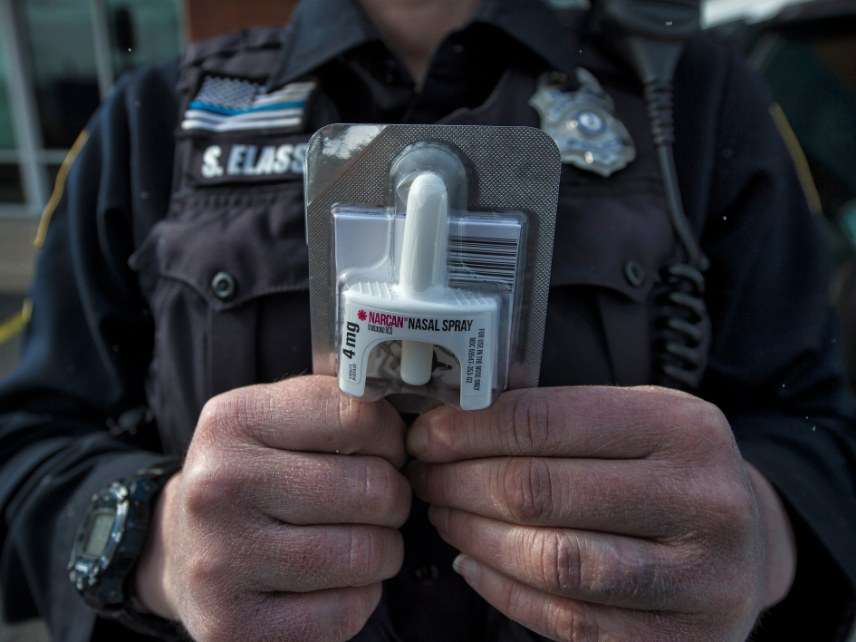Harm Reduction Is Helping Reduce Ohio Opioid Overdose Deaths
Success attributed to tools like naloxone, not punitive drug wars.

Ohio has been hit hard by the effects of opioid abuse, ranking as one of the top five states for rates of overdose deaths. The rate dramatically increased over the past few years, far above and beyond the proportions of the increase we've seen nationally. Last year Ohio saw more than 4,800 opioid overdose deaths, a record for the state.
But now the numbers are finally going down in some Ohio communities. Dayton has seen a dramatic 54 percent drop in opioid overdose deaths this year. Hamilton County (home of Cincinnati) is seeing a 31 percent drop in overdose deaths this year and on Monday was the focus of a CBS report.
There are several reasons why the overdose rates are dropping, but one thing seems pretty consistent: Harm reduction, not punitive responses by police and prosecutors, is what's saving lives.
Public health officials in these areas have flooded the communities with Narcan, the brand name for naloxone, the drug that reverses the effects of opioid overdoses. Over the course of a year, the office of Hamilton County Public Health has handed out more than 37,000 doses. It's had a huge impact. Last year emergency responders in Hamilton County say they responded to eight overdose calls per day. This year that number is five. When a CBS correspondent rode along with paramedics during a visit, they didn't have any overdose calls at all.
It's also worth noting the impact on emergency services themselves. The county reported during this time a 42 percent drop in emergency visits and a 37 percent drop in emergency calls to respond to drug overdoses. So while taxpayers are likely shouldering the costs of providing Narcan, it can't help but be cheaper than the cost of sending out crews to respond to overdoses. Another benefit is the impact it has ha on availability of doctors and nurses in emergency rooms.
Watch CBS's report on Hamilton County's successes here. The New York Times explored Dayton's decline in November here. Note in the Times coverage that Dayton's Police Department and its chief are on board with the pursuit of harm reduction rather than arrests, and that's been vital to Dayton's successes.
Editor's Note: As of February 29, 2024, commenting privileges on reason.com posts are limited to Reason Plus subscribers. Past commenters are grandfathered in for a temporary period. Subscribe here to preserve your ability to comment. Your Reason Plus subscription also gives you an ad-free version of reason.com, along with full access to the digital edition and archives of Reason magazine. We request that comments be civil and on-topic. We do not moderate or assume any responsibility for comments, which are owned by the readers who post them. Comments do not represent the views of reason.com or Reason Foundation. We reserve the right to delete any comment and ban commenters for any reason at any time. Comments may only be edited within 5 minutes of posting. Report abuses.
Please to post comments


So while taxpayers are likely shouldering the costs of providing Narcan, it can't help but be cheaper than the cost of sending out crews to respond to overdoses.
I bet I can think of an even cheaper solution.
Oh, you! 😎
Make opioids available over the counter, so people suffering from pain can just buy them?
Public health officials in these areas have flooded the communities with Narcan, the brand name for naloxone, the drug that reverses the effects of opioid overdoses.
Consider the dilemma when someone starts putting it in vape juice.
Or when the local Democratic party (also known as the local Media) discover Narcan is produced by ADAPT Pharma, a... *whispers* corporation.
I'm sure Lizzie Warren will fix *that* toot sweet.
it can't help but be cheaper than the cost of sending out crews to respond to overdoses.
"Bring out your dead!"
*clang*
"Bring out your dead!"
*clang*
Those guys pulling the cart though are probably in a union and are raking in 6 figure salaries with a defined pension. I mean you have one guy whose job is just to walk next to the cart and yell. Why can't one of the other 3 do that while pulling the cart; I'll tell you why because he is the nephew of a local developer and got the job cause of his uncle's ties to city hall. Not to mention the cart itself, had to be made in America instead of being imported because the cart maker got his buddies in Washington to slap a 50% tariff on all imported carts. Nope you won't fool me with your "common sense" dead body disposal policy.
How about the rate of opioid addiction? Is that down, up, or the same?